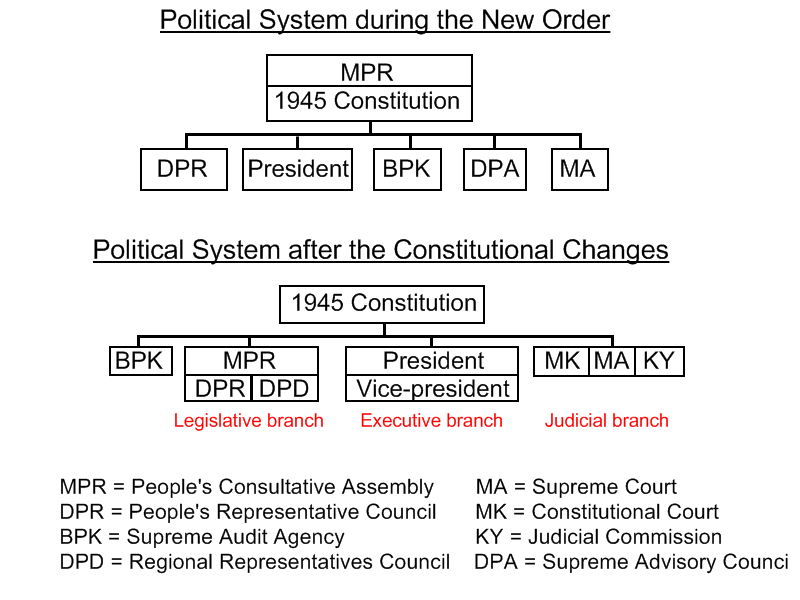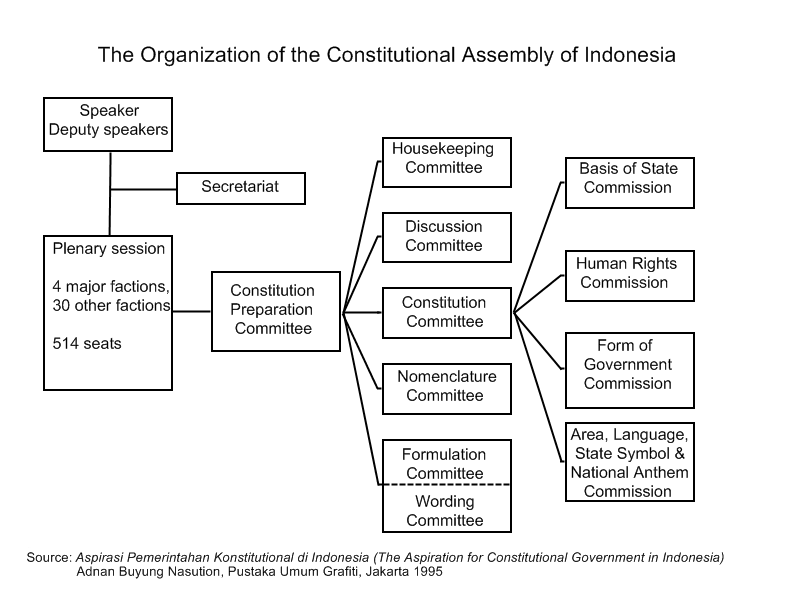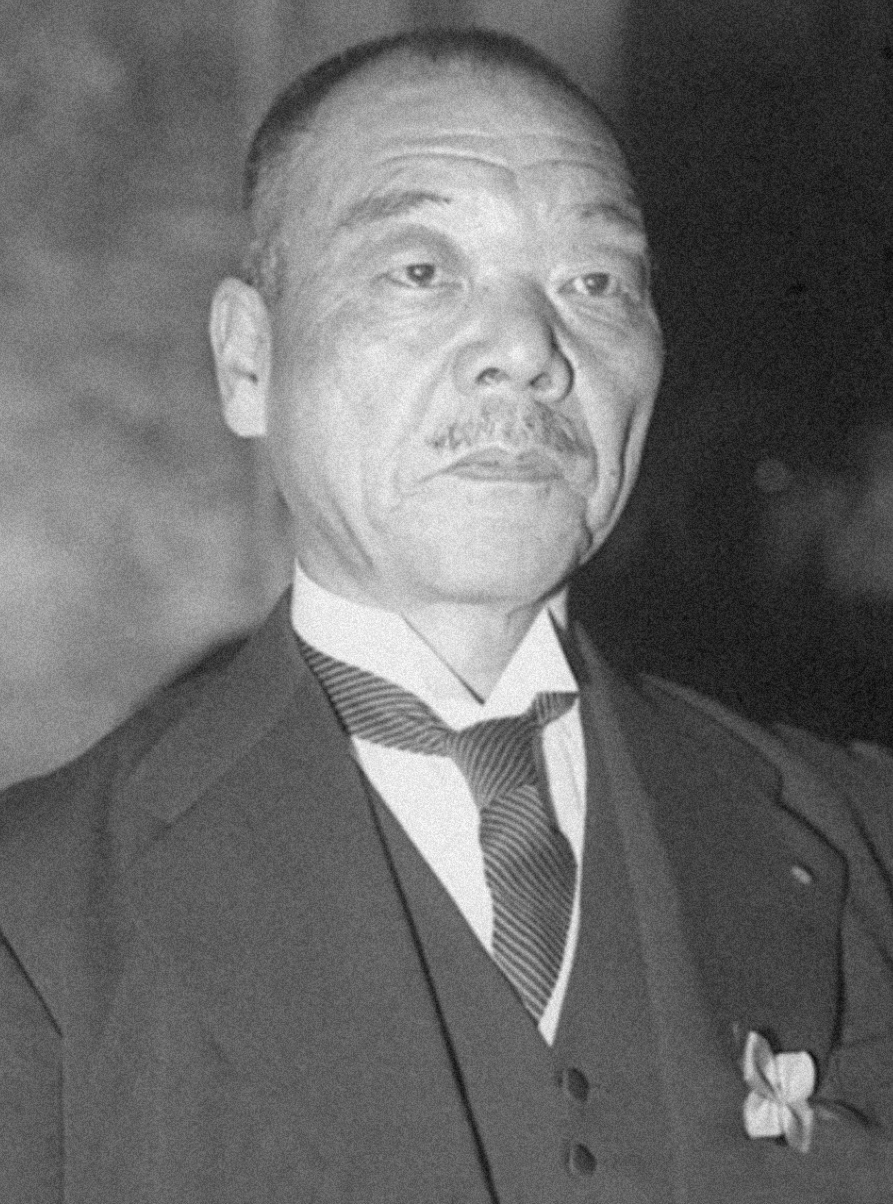|
President Sukarno's 1959 Decree
The Presidential Decree of July 5, 1959 (legally the Decree of the President of the Republic of Indonesia Number 150 of 1959 on the Return to the Constitution of 1945, id, Keputusan Presiden Republik Indonesia Nomor 150 Tahun 1959 Tentang Kembali kepada Undang-Undang Dasar 1945) was issued by President Sukarno in the face of the inability of the Constitutional Assembly of Indonesia to achieve the two-thirds majority to reimpose the 1945 Constitution. It was army chief of staff Abdul Haris Nasution who concluded that this would be the only way to bring about the reintroduction of a constitution that paved the way for the military to play a greater role in the running of the state, ushering in the period known as the "guided democracy" (1959–1966). The Decree The decree, which was read by Sukarno at the Merdeka Palace reads as follows: Aftermath After Sukarno enacted the decree, he dissolved the Constitutional Assembly by abrogating the 1950 Provisional Constitution. This de ... [...More Info...] [...Related Items...] OR: [Wikipedia] [Google] [Baidu] |
Sukarno
Sukarno). (; born Koesno Sosrodihardjo, ; 6 June 1901 – 21 June 1970) was an Indonesian statesman, orator, revolutionary, and nationalist who was the first president of Indonesia, serving from 1945 to 1967. Sukarno was the leader of the Indonesian struggle for independence from the Dutch colonialists. He was a prominent leader of Indonesia's nationalist movement during the colonial period and spent over a decade under Dutch detention until released by the invading Japanese forces in World War II. Sukarno and his fellow nationalists collaborated to garner support for the Japanese war effort from the population, in exchange for Japanese aid in spreading nationalist ideas. Upon Japanese surrender, Sukarno and Mohammad Hatta declared Indonesian independence on 17 August 1945, and Sukarno was appointed president. He led the Indonesian resistance to Dutch re-colonisation efforts via diplomatic and military means until the Dutch recognition of Indonesian independence ... [...More Info...] [...Related Items...] OR: [Wikipedia] [Google] [Baidu] |
Merdeka Palace
The Merdeka Palace (; also known in Indonesian as ''Istana Gambir'' and during the Dutch colonial times as ''Paleis te Koningsplein''), is one of six presidential palaces in Indonesia. It is located on the north side of the Merdeka Square in Central Jakarta, Indonesia and is used as the official residence of the president of the Republic of Indonesia President most commonly refers to: *President (corporate title) * President (education), a leader of a college or university *President (government title) President may also refer to: Automobiles * Nissan President, a 1966–2010 Japanese f .... The palace was a residence for the governor-general of the Dutch East Indies during the colonial era. In 1949, the palace was renamed Merdeka Palace, "(ke)merdeka(an)" meaning "freedom" or "independence". The Merdeka Palace is part of the Jakarta Presidential Palace Complex, which also includes the Istana Negara (Jakarta), Negara Palace, Wisma Negara (state guest house), Sekretaria ... [...More Info...] [...Related Items...] OR: [Wikipedia] [Google] [Baidu] |
Jakarta
Jakarta (; , bew, Jakarte), officially the Special Capital Region of Jakarta ( id, Daerah Khusus Ibukota Jakarta) is the capital and largest city of Indonesia. Lying on the northwest coast of Java, the world's most populous island, Jakarta is the largest city in Southeast Asia and serves as the diplomatic capital of ASEAN. The city is the economic, cultural, and political centre of Indonesia. It possesses a province-level status and has a population of 10,609,681 as of mid 2021.Badan Pusat Statistik, Jakarta, 2022. Although Jakarta extends over only , and thus has the smallest area of any Indonesian province, its metropolitan area covers , which includes the satellite cities Bogor, Depok, Tangerang, South Tangerang, and Bekasi, and has an estimated population of 35 million , making it the largest urban area in Indonesia and the second-largest in the world (after Tokyo). Jakarta ranks first among the Indonesian provinces in human development index. Jakarta's busin ... [...More Info...] [...Related Items...] OR: [Wikipedia] [Google] [Baidu] |
Liberal Democracy Period In Indonesia
The Liberal Democracy period in Indonesia (Indonesian: ''Demokrasi Liberal''), also known as the Era of Parliamentary Democracy, was a period in Indonesian political history, when Indonesia was under a liberal democracy system which began on 17 August 1950 following the dissolution of the federal United States of Indonesia less than a year after its formation, and ended with the imposition of martial law and President Sukarno's decree, resulting in the introduction of the Guided Democracy period on 5 July 1959. On August 17, 1950, the Republic of the United States of Indonesia (RIS), which was a form of state as a result of the Round Table Conference agreement and the recognition of sovereignty with the Netherlands, was officially dissolved. The government system was also changed to a Parliamentary Democracy and based on the Provisional Constitution of 1950. The period of liberal democracy was marked by the growth of political parties and the enactment of a parliamentary sy ... [...More Info...] [...Related Items...] OR: [Wikipedia] [Google] [Baidu] |
Provisional Constitution Of 1950
The Provisional Constitution of 1950 ( id, Undang-Undang Dasar Sementara Republik Indonesia 1950, ''UUDS 1950'') replaced the Federal Constitution of 1949 when Indonesia unilaterally withdrew from Netherlands-Indonesia Union, the union with the Netherlands agreed at the Dutch-Indonesian Round Table Conference, Round Table Conference and returned to being a unitary state. It came into force on 17 August 1950. It was abrogated on 5 July 1959 when President Sukarno issued a decree dissolving the Constituent Assembly of Indonesia, Constitutional Assembly and restoring the 1945 Constitution of Indonesia. Background On 27 December 1949, following the handover of sovereignty from the Netherlands to the United States of Indonesia (RUSI), the Federal Constitution of 1949 replaced the 1945 Constitution of Indonesia. However over the next few months, there appeared a groundswell of public opinion for a return to a unitary state. By early May 1950, this had become the major priority for th ... [...More Info...] [...Related Items...] OR: [Wikipedia] [Google] [Baidu] |
Constitution Of Indonesia
The 1945 State Constitution of the Republic of Indonesia ( id, Undang-Undang Dasar Negara Republik Indonesia Tahun 1945, commonly abbreviated as ''UUD 1945'' or ''UUD '45'') is the supreme law and basis for all laws of Indonesia. The constitution was written in June, July, and August 1945, in the final months of the Japanese occupation of the Dutch East Indies at the end of World War II. It was abrogated by the Federal Constitution of 1949 and the Provisional Constitution of 1950, but restored by President Sukarno's 1959 Decree. The 1945 Constitution sets forth the Pancasila, the five nationalist principles, as the embodiment of basic principles of an independent Indonesian state. It provides for a limited separation of executive, legislative, and judicial powers. The governmental system has been described as "presidential with parliamentary characteristics."King (2007) Following major upheavals in 1998 and the resignation of President Suharto, several political reforms wer ... [...More Info...] [...Related Items...] OR: [Wikipedia] [Google] [Baidu] |
Constitutional Assembly Of Indonesia
The Constitutional Assembly ( id, Konstituante) was a body elected in 1955 to draw up a permanent constitution for the Republic of Indonesia. It sat between 10 November 1956 and 2 July 1959. It was dissolved by then President Sukarno in a decree issued on 5 July 1959 which reimposed the 1945 Constitution. Background On 17 August 1945, Sukarno proclaimed the independence of the Republic of Indonesia. The next day, a meeting of the Preparatory Committee for Indonesian Independence chaired by President Sukarno officially adopted the Constitution of Indonesia, which had been drawn up by the Investigating Committee for Preparatory Work for Independence in the months leading up to the Japanese surrender. In a speech, Sukarno stated that the constitution was "a temporary constitution... a lightning constitution", and that a more permanent version would be drawn up when circumstances permitted. It was not until 1949 that the Netherlands formally transferred sovereignty to Indones ... [...More Info...] [...Related Items...] OR: [Wikipedia] [Google] [Baidu] |
Abdul Haris Nasution
General of the Army Abdul Haris Nasution ( Old Spelling: Abdoel Haris Nasution; 3 December 1918 – 6 September 2000), was a high-ranking Indonesian general and politician. He served in the military during the Indonesian National Revolution and he remained in the military during subsequent turmoil of the Parliamentary democracy and Guided Democracy. Following the fall of President Sukarno from power, he became the Speaker of the People's Consultative Assembly under president Suharto. Born into a Batak Muslim family, in the village of Hutapungkut, Dutch East Indies, he studied teaching and enrolled at a military academy in Bandung. He became a member of the Royal Netherlands East Indies Army, but following the Japanese invasion, he joined the Defenders of the Homeland. Following the proclamation of independence, he enlisted in the fledgling Indonesian armed forces, and fought during the Indonesian National Revolution. In 1946, he was appointed commander of the Siliwangi ... [...More Info...] [...Related Items...] OR: [Wikipedia] [Google] [Baidu] |
Guided Democracy In Indonesia
Guided Democracy () was the political system in place in Indonesia from 1959 until the New Order began in 1966. It was the brainchild of President Sukarno, and was an attempt to bring about political stability. Sukarno believed that the parliamentarian system implemented during the liberal democracy period in Indonesia was ineffective due to its divisive political situation at that time. Instead, he sought a system based on the traditional village system of discussion and consensus, which occurred under the guidance of village elders. With the declaration of martial law and the introduction of this system, Indonesia returned to the presidential system and Sukarno became the head of government again. Sukarno proposed a threefold blend of (nationalism), (religion), and (communism) into a co-operative Nas-A-Kom or Nasakom governmental concept. This was intended to satisfy the four main factions in Indonesian politics—the army, the secular nationalists, Islamic groups, and ... [...More Info...] [...Related Items...] OR: [Wikipedia] [Google] [Baidu] |
Jakarta Charter
The Jakarta Charter ( id, Piagam Jakarta) was a document drawn up by members of the Indonesian Investigating Committee for Preparatory Work for Independence (BPUPK) on 22 June 1945 in Jakarta that later formed the basis of the preamble to the Constitution of Indonesia. The document contained the five principles of the Pancasila ideology, but it also included an obligation for Muslims to abide by Shariah law. This obligation, which was also known as the "Seven Words" (''tujuh kata''), was eventually deleted from the enacted constitution after the Indonesian declaration of independence on 18 August 1945. Following the deletion of the "Seven Words" efforts by Islamic parties continued to seek its inclusion, most notably in 1959, when the 1945 constitution was suspended; in 1968, during the Transition to the New Order; and in 2002, following the end of the New Order and the beginning of the ''Reformasi'' era. Background Founding of the BPUPK Prime Minister of Japan, Kuniaki ... [...More Info...] [...Related Items...] OR: [Wikipedia] [Google] [Baidu] |
Cabinet Of Indonesia
The Cabinet of the Republic of Indonesia ( id, Kabinet Republik Indonesia) is part of the executive branch of the Indonesian government. It is composed of the most senior appointed officers of the executive branch of the government serving under the president. Members of the Cabinet (except for the vice president) serve at the pleasure of the president, who can dismiss them at will for no cause. Indonesia has seen dozens of cabinets since independence in 1945. Although after the New Order most cabinets remained unchanged for five years at a time. Most cabinets are referred to by the names given them at the time of formation. The current presidential cabinet is the Onward Indonesia Cabinet of Joko Widodo. History The concept of a cabinet is not mentioned explicitly in the 1945 Constitution, so Indonesia's cabinets since 14 November 1945 are the result of administrative convention. There have been two types of cabinet in Indonesian history; presidential and parliamentary. In pr ... [...More Info...] [...Related Items...] OR: [Wikipedia] [Google] [Baidu] |
President Of Indonesia
The President of the Republic of Indonesia ( id, Presiden Republik Indonesia) is both the head of state and the head of government of the Republic of Indonesia. The president leads the executive branch of the Indonesian government and is the commander-in-chief of the Indonesian National Armed Forces. Since 2004, the president and vice president are directly elected to a five-year term, once renewable, allowing for a maximum of 10 years in office. Joko Widodo is the seventh and current president of Indonesia. He assumed office on 20 October 2014. History Sukarno era The Indonesian presidency was established during the formulation of the 1945 Constitution by the Investigating Committee for Preparatory Work for Independence (BPUPK). The office was first filled on 18 August 1945 when Sukarno was elected by acclamation by the Preparatory Committee for Indonesian Independence (PPKI) because according to the Transitional Provisions of the Constitution, "the President ... [...More Info...] [...Related Items...] OR: [Wikipedia] [Google] [Baidu] |




